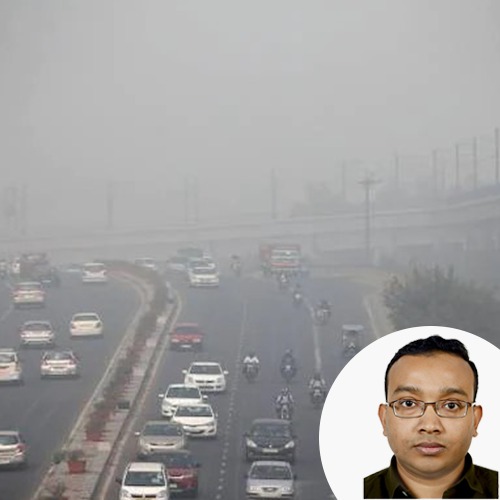Delhi NCR is grappling with severe air pollution. There are news reports that attribute the sudden spike in air pollution to an increase in farm fires in the Northern States of the country. Is this the sole factor behind the toxic air?
In an exclusive interview with Siddhartha Mandal, Senior Research Scientist, Centre for Chronic Disease Control, New Delhi, we find out the health cost of air pollution. What policy interventions are required to improve the quality of air that surrounds us?
How severe is the air in Delhi and NCR?
The air in Delhi NCR is poor quality, not only in October-November but in other times of the year as well. The annual average PM2.5 levels are close to 100ug/m3 wherein the National Standards are set at 40 for annual averages. There are other pollutants as well including black carbon and nitrogen dioxide depending on different sources of emission. Pollution levels spike specifically during the winter, aided by temperature inversion and there is significant variability across the different geographies of NCR.
What are the immediate health risks?
Air pollutants have been linked to multiple health outcomes with long- and short-term effects ranging from pregnancy and birth outcomes to cognitive outcomes in the elderly. Short-term effects usually are related to respiratory and opthalmological issues. Fine particulate matter can cause inflammation in the lungs and exacerbate existing respiratory conditions. Chronic diseases and risk factors are also affected by air pollutants, with elevated levels of PM2.5 influencing systemic inflammation and the autonomic nervous system, which are related to numerous cardiovascular and cardiometabolic health outcomes.
What are the main reasons for the spike in air pollution during this time of the year?
Delhi NCR has multiple anthropogenic sources of air pollutants, such as vehicular, industrial, agricultural and construction. Pollutants from these sources, combined with meteorological conditions cause a spike in levels during October-November. With the lowering of temperatures and lack of wind speed, the air in contact with the earth’s surface gets colder. Pollutants in this cold air are not dispersed into the upper atmosphere because colder air is heavy and stays close to the surface which increases the levels.
Is there any evidence to suggest that there are increased hospitalisations etc. due to air pollution?
Variations in air pollution have been linked to increased hospitalisations in multiple epidemiological studies. Short-term exposure to air pollution has been linked with increased hospitalisation due to asthma, pneumonia and other respiratory distress. Long-term exposures have been linked with increased hospitalisation due to stroke and other cardiovascular diseases. However, most of these studies have been conducted in countries with lower levels compared to Delhi NCR. Unfortunately, in India, there is a lack of comprehensive digitised medical records at a population level to track hospitalisations which could help us understand the situation.
As a scientist who is deeply associated with this, please suggest remedies/policies interventions that can improve the situation.
Both the government and the general population first need to realise that ambient air pollution is not solely a seasonal problem and is not limited to certain geographical areas. So the policies to tackle ambient air pollution must be devised at a population level with coordination between multiple ministries, keeping in mind short-term, medium-term and long-term goals. Given that there have been numerous studies quantifying the sources of air pollution in NCR, we could start simultaneously with interventions such as incentivising public transport usage, providing farmers with alternatives to crop burning, managing and controlling traffic routes, tracking polluting industries along with enhancing public awareness. The efficacy of these interventions should be evaluated in long-term (even if at a smaller geographical scale) rather than expecting short-term benefits. More importantly, the benefits of these interventions should be evaluated in the light of health benefits rather than simply economic benefits since the high burden of chronic diseases in this country brings a massive loss in quality of life alongside an increased financial burden for a large section of the population.
How do other countries fight air pollution? Are there any case studies that can support improvement?
There have been several instances where public policy has helped control ambient air pollution. Some prominent examples include London and Barcelona in Europe. The Great London fog of 1952 was attributed to coal fires and has been related to an estimated 4000 extra deaths. The Clean Air Act of 1956 enabled the shift to cleaner fuels, relocated heavy industry and introduced stricter emission standards while paving the way for future acts such as the Clean Air Act of 1968 and the Environment Act 1995. At present, the major source of air pollution in London is road traffic, with annual average levels ranging between 10-15 ug/m3.
Several epidemiological studies showed the effects of ambient traffic-related air pollution with health, specifically cognitive outcomes in school going children in the city of Barcelona. The municipal and metropolitan authorities set up a body to design and implement measures to control air pollution, which brought together a diverse and cross-cutting working group representing all the stakeholders, including municipal authorities, business and financial interests, social actors, ecologists and scientists as well as the transport and health sectors. The major policies and interventions include reducing the number of journeys made in private vehicles, restricting more polluting vehicles, fostering more sustainable public transport, promoting the use of bicycles, promoting a low-emission zone in the area around Barcelona’s ring roads and taking measures to protect the health of more vulnerable groups such as children.
It is important to acknowledge the fact that the problem of ambient air pollution affects the entire population and some groups more than others. Thus the solution to the problem must also involve all stakeholders and comprehensive and contextualized solutions must be devised and implemented with long-term goals in mind.












